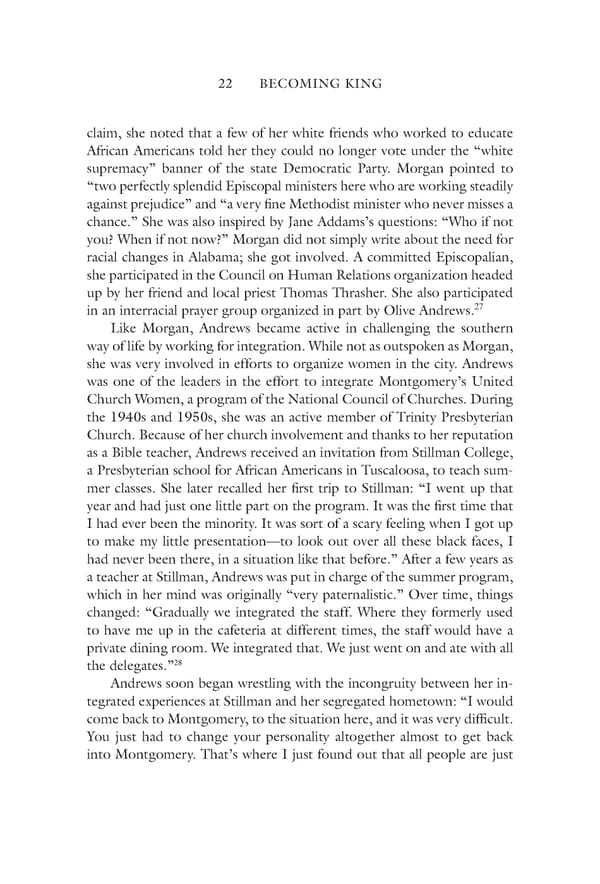22 BECOMING KING claim, she noted that a few of her white friends who worked to educate African Americans told her they could no longer vote under the “white supremacy” banner of the state Democratic Party. Morgan pointed to “two perfectly splendid Episcopal ministers here who are working steadily against prejudice” and “a very fine Methodist minister who never misses a chance.” She was also inspired by Jane Addams’s questions: “Who if not you? When if not now?” Morgan did not simply write about the need for racial changes in Alabama; she got involved. A committed Episcopalian, she participated in the Council on Human Relations organization headed up by her friend and local priest Thomas Thrasher. She also participated 27 in an interracial prayer group organized in part by Olive Andrews. Like Morgan, Andrews became active in challenging the southern way of life by working for integration. While not as outspoken as Morgan, she was very involved in efforts to organize women in the city. Andrews was one of the leaders in the effort to integrate Montgomery’s United Church Women, a program of the National Council of Churches. During the 1940s and 1950s, she was an active member of Trinity Presbyterian Church. Because of her church involvement and thanks to her reputation as a Bible teacher, Andrews received an invitation from Stillman College, a Presbyterian school for African Americans in Tuscaloosa, to teach sum- mer classes. She later recalled her first trip to Stillman: “I went up that year and had just one little part on the program. It was the first time that I had ever been the minority. It was sort of a scary feeling when I got up to make my little presentation—to look out over all these black faces, I had never been there, in a situation like that before.” After a few years as a teacher at Stillman, Andrews was put in charge of the summer program, which in her mind was originally “very paternalistic.” Over time, things changed: “Gradually we integrated the staff. Where they formerly used to have me up in the cafeteria at different times, the staff would have a private dining room. We integrated that. We just went on and ate with all 28 the delegates.” Andrews soon began wrestling with the incongruity between her in- tegrated experiences at Stillman and her segregated hometown: “I would come back to Montgomery, to the situation here, and it was very difficult. You just had to change your personality altogether almost to get back into Montgomery. That’s where I just found out that all people are just
 Becoming King: Martin Luther King Jr. Page 42 Page 44
Becoming King: Martin Luther King Jr. Page 42 Page 44